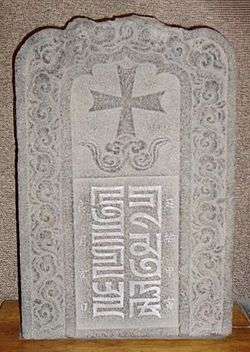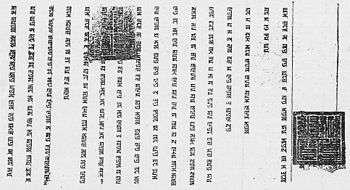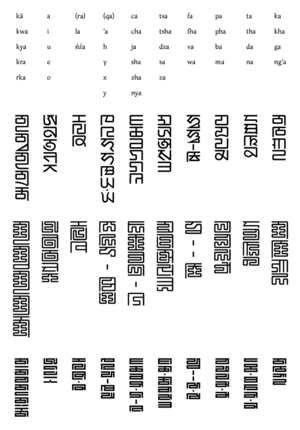ʼPhags-pa script
The ʼPhags-pa script[1] is an alphabet designed by the Tibetan monk and State Preceptor (later Imperial Preceptor) Drogön Chögyal Phagpa for Kublai Khan, the founder of the Yuan dynasty, as a unified script for the written languages within the Yuan. The actual use of this script was limited to about a hundred years during the Mongol Yuan dynasty, and it fell out of use with the advent of the Ming dynasty.
| ʼPhags-pa | |
|---|---|
 | |
| Type | |
| Languages | |
| Creator | Drogön Chögyal Phagpa |
Time period | 1269 – c. 1360 |
Parent systems | |
Child systems | Possibly Hangul |
Sister systems | Lepcha |
| Direction | Top-to-bottom |
| ISO 15924 | Phag, 331 |
Unicode alias | Phags-pa |
Unicode range | U+A840–U+A87F |
[a] The Semitic origin of the Brahmic scripts is not universally agreed upon. | |
| Chinese romanization |
|---|
| Mandarin |
|
Sichuanese |
| Wu |
| Yue |
| Southern Min |
| Eastern Min |
| Northern Min |
| Pu-Xian Min |
| Hainanese |
| Gan |
|
Chang-Du dialect |
| Hakka |
| Xiang |
|
Chang–Yi dialects |
| See also |
|
Other transliterations |
| Brahmic scripts |
|---|
| The Brahmic script and its descendants |
|
Northern Brahmic
|
|
Southern Brahmic
|
It was used to write and transcribe varieties of Chinese, the Tibetic languages, Mongolian, the Uyghur language, Sanskrit, Persian,[2][3] and other neighboring languages during the Yuan era.[4][5] For historical linguists, the documentation of its use provides clues about the changes in these languages.
Its descendant systems include Horizontal square script, used to write Tibetan and Sanskrit. There is a theory that the Korean Hangul alphabet was also partly inspired by ʼPhags-pa (see Origin of Hangul). During the Pax Mongolica the script has even made numerous appearances in western medieval art.
Nomenclature
ʼPhags-pa script: ꡏꡡꡃ ꡣꡡꡙ ꡐꡜꡞ mongxol tshi, "Mongolian script";
Mongolian: дөрвөлжин үсэг dörvöljin üseg, "square script";
Tibetan: ཧོར་ཡིག་གསར་པ་, Wylie: hor yig gsar ba "new Mongolian script";
Yuan dynasty Chinese: 蒙古新字; pinyin: měnggǔ xīnzì "new Mongolian script";
History
During the Mongol Empire, the Mongols wanted a universal script to write down the languages of the people they subjugated. The Uyghur-based Mongolian alphabet is not a perfect fit for the Middle Mongol language, and it would be impractical to extend it to a language with a very different phonology like Chinese. Therefore, during the Yuan dynasty (c. 1269), Kublai Khan asked the Tibetan monk ʼPhags-pa to design a new alphabet for use by the whole empire. ʼPhags-pa extended his native Tibetan alphabet[3] to encompass Mongol and Chinese, evidently Central Plains Mandarin.[6] The resulting 38 letters have been known by several descriptive names, such as "square script" based on their shape, but today are primarily known as the ʼPhags-pa alphabet.
Descending from Tibetan script it is part of the Brahmic family of scripts, which includes Devanagari and scripts used throughout Southeast Asia and Central Asia.[3] It is unique among Brahmic scripts in that it is written top bottom,[3] like how Chinese used to be written; and like the Manchu alphabet or later Mongolian alphabet.
Despite its origin, the script was written vertically (top to bottom) like the previous Mongolian scripts. It did not receive wide acceptance and was not a popular script even among the elite Mongols themselves, although it was used as an official script of the Yuan dynasty until the early 1350s[7] when the Red Turban Rebellion started. After this it was mainly used as a phonetic gloss for Mongolians learning Chinese characters. It was also used as one of the scripts on Tibetan currency in the twentieth century, as script for Tibetan seal inscriptions from the Middle Ages up to the 20th century and for inscriptions on the entrance doors of Tibetan monasteries.
Syllable formation
Although it is an alphabet, phagspa is written like a syllabary or abugida, with letters forming a single syllable glued or 'ligated' together.[3]


Top: Approximate values in Middle Chinese. (Values in parentheses were not used for Chinese.)
Second: Standard letter forms.
Third: Seal script forms. (A few letters, marked by hyphens, are not distinct from the preceding letter.)
Unlike the ancestral Tibetan script, all ʼPhags-pa letters are written in temporal order (that is, /CV/ is written in the order C–V for all vowels) and in-line (that is, the vowels are not diacritics). However, vowel letters retain distinct initial forms, and short /a/ is not written except initially, making ʼPhags-pa transitional between an abugida, a syllabary, and a full alphabet. The letters of a ʼPhags-pa syllable are linked together so that they form syllabic blocks.[3]
Typographic forms
ʼPhags-pa was written in a variety of graphic forms. The standard form (top, at right) was blocky, but a "Tibetan" form (bottom) was even more so, consisting almost entirely of straight orthogonal lines and right angles. A "seal script" form (Chinese 蒙古篆字 měnggǔ zhuànzì "Mongolian Seal Script"), used for imperial seals and the like, was more elaborate, with squared sinusoidal lines and spirals.
Korean records state that hangul was based on an "Old Seal Script" (古篆字), which may be ʼPhags-pa and a reference to its Chinese name 蒙古篆字 měnggǔ zhuànzì (see origin of hangul). However, it is the simpler standard form of ʼPhags-pa that is the closer graphic match to hangul.
Letters
Following are the initials of the ʼPhags-pa script as presented in Menggu Ziyun. They are ordered according to the Chinese philological tradition of the 36 initials.
| No. | Name | Phonetic value | ʼPhags-pa letter | ʼPhags-pa Initial | Notes |
|---|---|---|---|---|---|
| 1 | 見 jiàn | *[k] | ꡂ | g- | |
| 2 | 溪 qī | *[kʰ] | ꡁ | kh- | |
| 3 | 群 qún | *[ɡ] | ꡀ | k- | |
| 4 | 疑 yí | *[ŋ] | ꡃ | ng- | |
| 5 | 端 duān | *[t] | ꡊ | d- | |
| 6 | 透 tòu | *[tʰ] | ꡉ | th- | |
| 7 | 定 dìng | *[d] | ꡈ | t- | |
| 8 | 泥 ní | *[n] | ꡋ | n- | |
| 9 | 知 zhī | *[ʈ] | ꡆ | j- | |
| 10 | 徹 chè | *[ʈʰ] | ꡅ | ch- | |
| 11 | 澄 chéng | *[ɖ] | ꡄ | c- | |
| 12 | 娘 niáng | *[ɳ] | ꡇ | ny- | |
| 13 | 幫 bāng | *[p] | ꡎ | b- | |
| 14 | 滂 pāng | *[pʰ] | ꡍ | ph- | |
| 15 | 並 bìng | *[b] | ꡌ | p- | |
| 16 | 明 míng | *[m] | ꡏ | m- | |
| 17 | 非 fēi | *[p̪] | ꡤ | f- | Normal form of the letter fa |
| 18 | 敷 fū | *[p̪ʰ] | ꡰ | f¹- | Variant form of the letter fa |
| 19 | 奉 fèng | *[b̪] | ꡤ | f- | Normal form of the letter fa |
| 20 | 微 wēi | *[ɱ] | ꡓ | w- | Letter wa represents [v] |
| 21 | 精 jīng | *[ts] | ꡒ | dz- | |
| 22 | 清 qīng | *[tsʰ] | ꡑ | tsh- | |
| 23 | 從 cóng | *[dz] | ꡐ | ts- | |
| 24 | 心 xīn | *[s] | ꡛ | s- | |
| 25 | 邪 xié | *[z] | ꡕ | z- | |
| 26 | 照 zhào | *[tɕ] | ꡆ | j- | |
| 27 | 穿 chuān | *[tɕʰ] | ꡅ | ch- | |
| 28 | 床 chuáng | *[dʑ] | ꡄ | c- | |
| 29 | 審 shěn | *[ɕ] | ꡮ | sh¹- | Variant form of the letter sha |
| 30 | 禪 chán | *[ʑ] | ꡚ | sh- | Normal form of the letter sha |
| 31 | 曉 xiǎo | *[x] | ꡜ | h- | Normal form of the letter ha |
| 32 | 匣 xiá | *[ɣ] | ꡣ | x- | |
| ꡯ | h¹- | Variant form of the letter ha | |||
| 33 | 影 yǐng | *[ʔ] | ꡖ | ʼ- | glottal stop |
| ꡗ | y- | Normal form of the letter ya | |||
| 34 | 喻 yù | *[j] | ꡝ | - | null initial |
| ꡭ | y¹- | Variant form of the letter ya | |||
| 35 | 來 lái | *[l] | ꡙ | l- | |
| 36 | 日 rì | *[ɲ] | ꡔ | zh- |
Unicode
ʼPhags-pa script was added to the Unicode Standard in July 2006 with the release of version 5.0.
The Unicode block for ʼPhags-pa is U+A840–U+A877:
| Phags-pa[1][2] Official Unicode Consortium code chart (PDF) | ||||||||||||||||
| 0 | 1 | 2 | 3 | 4 | 5 | 6 | 7 | 8 | 9 | A | B | C | D | E | F | |
| U+A84x | ꡀ | ꡁ | ꡂ | ꡃ | ꡄ | ꡅ | ꡆ | ꡇ | ꡈ | ꡉ | ꡊ | ꡋ | ꡌ | ꡍ | ꡎ | ꡏ |
| U+A85x | ꡐ | ꡑ | ꡒ | ꡓ | ꡔ | ꡕ | ꡖ | ꡗ | ꡘ | ꡙ | ꡚ | ꡛ | ꡜ | ꡝ | ꡞ | ꡟ |
| U+A86x | ꡠ | ꡡ | ꡢ | ꡣ | ꡤ | ꡥ | ꡦ | ꡧ | ꡨ | ꡩ | ꡪ | ꡫ | ꡬ | ꡭ | ꡮ | ꡯ |
| U+A87x | ꡰ | ꡱ | ꡲ | ꡳ | ꡴ | ꡵ | ꡶ | ꡷ | ||||||||
| Notes | ||||||||||||||||
U+A856 ꡖ PHAGS-PA LETTER SMALL A is transliterated using U+A78F ꞏ LATIN LETTER SINOLOGICAL DOT from the Latin Extended-D Unicode block.[8]
See also
- Brahmic scripts
- Mongolian alphabets
- Origin of hangul
- Mongol elements in Western medieval art
- Menggu Ziyun (Yuan dynasty ʼPhags-pa—Chinese rhyming dictionary)
References
- ʼPhags-pa script: ꡏꡡꡃ ꡣꡡꡙ ꡐꡜꡞ mongxol tshi, "Mongolian script"; Mongolian: дөрвөлжин үсэг dörvöljin üseg, "square script"; Tibetan: ཧོར་ཡིག་གསར་པ་, Wylie: hor yig gsar ba "new Mongolian script"; Chinese: 蒙古新字; pinyin: měnggǔ xīnzì "new Mongolian script" (Yuan dynasty usage) or Chinese: 八思巴文; pinyin: bāsībā wén "ʼPhags-pa writing" (modern usage)
- "CHINESE-IRANIAN RELATIONS viii. Persian Lang. – Encyclopaedia Iranica". www.iranicaonline.org. Retrieved 2019-06-28.
- "BabelStone : 'Phags-pa Script : Description". www.babelstone.co.uk. Retrieved 2019-06-28.
- Theobald, Ulrich. "The 'Phags-pa Script (www.chinaknowledge.de)". www.chinaknowledge.de. Retrieved 2019-06-28.
- "BabelStone : Phags-pa Script : Overview". www.babelstone.co.uk. Retrieved 2019-06-28.
- Coblin, W. South (2002). "Reflections on the Study of Post-Medieval Chinese Historical Phonology". In 何大安 (ed.). 第三屆國際漢學會議論文集: 語言組. 南北是非 : 漢語方言的差異與變化 [Papers from the Third International Conference on Sinology, Linguistics Section. Dialect Variations in Chinese]. Taibei: Institute of Linguistics, Academia Sinica. pp. 23–50. ISBN 978-957-671-936-3. Archived from the original (PDF) on 2013-05-16. Retrieved 21 October 2011. p. 31.
- Strange Names of God: The Missionary Translation of the Divine Name and the Chinese Responses to Matteo Ricci's "Shangti" in Late Ming China, 1583-1644, by Sangkeun Kim, p139
- West, Andrew (2009-04-04). "L2/09-031R: Proposal to encode a Middle Dot letter for Phags-pa transliteration" (PDF).
Further reading
- Coblin, W. South (2006). A Handbook of ʼPhags-pa Chinese. ABC Dictionary Series. Honolulu: University of Hawai'i Press. ISBN 978-0-8248-3000-7.
- Everding, Karl-Heinz (2006). Herrscherurkunden aus der Zeit des mongolischen Großreiches für tibetische Adelshäuser, Geistliche und Klöster. Teil 1: Diplomata Mongolica. Mittelmongolische Urkunden in ʼPhags-pa-Schrift. Eidtion, Übersetzung, Analyse. Halle: International Institute for Tibetan and Buddhist Studies. ISBN 978-3-88280-074-6.
- Poppe, Nicholas (1957). The Mongolian Monuments in hP´ags-pa Script (Second ed.). Wiesbaden: Harrassowitz.
- Schuh, Dieter (1981). Grundlagen tibetischer Siegelkunde. Eine Untersuchung über tibetische Siegelaufschriften in ʼPhags-pa-Schrift. Sankt Augustin: VGH Wissenschaftsverlag. ISBN 978-3-88280-011-1.
- Sampson, Geoffrey (1985). Writing Systems: A Linguistic Introduction. Great Britain: Anchor Brenton Ltd. ISBN 978-0-09-156980-8.
- Coblin, W. South (2007). A Handbook of ʼPhags-Pa Chinese. ABC Chinese dictionary series. University of Hawaii Press. ISBN 978-0824830007. Retrieved 24 April 2014.CS1 maint: ref=harv (link)
- Denlinger, Paul. B. (1963). Chinese in Hp'ags-pa Script. Retrieved 24 April 2014.CS1 maint: ref=harv (link)
External links
| Wikimedia Commons has media related to Phagspa script. |